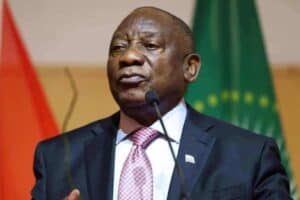Even if reforms get on track, global difficulties loom.

President Cyril Ramaphosa’s efforts to reform the economy can easily become a case of too little, too late.
Since taking office in February 2018, he has initiated much-needed reform, but the sluggish pace of implementation along with the sad state of the country’s finances leaves SA especially vulnerable should it have to go through an economic shock like the 2008 global financial crisis.
The current weakness can be seen in how well the country was positioned when it went through that crisis. Back then, SA had a budget surplus of 0.9%, with the repo rate sitting at 3.9%. When the government announces its national budget in a few weeks’ time, we will probably see the deficit increase to 6.5% and repo rates at 6.5%.
The International Monetary Fund (IMF), a lender of last resort for countries that have managed to get themselves into trouble, is not blind to the threats SA faces.
Read: IMF rumours may be the scare South Africa needs
In its 2019 Article IV Consultation Report on SA, it says that besides issues such as the high public sector wage bill and the debt of state-owned enterprises, the county’s efforts to reform its economy could be upended by events outside its control.
The report did not exactly say that SA needs a bit of luck to avoid an economic catastrophe, but it was certainly implied.
The IMF’s Risk Assessment Matrix rates the likelihood of “rising protectionism and retreat from multilateralism”, “sharp rise in risk premia” and “weaker-than-expected global growth in US, Europe and China” as high in the short to medium term.
Read: What an IMF bail-out will look like …
Apart from medium level risk of a downturn in the US economy, the IMF’s outlook for global risk is rather negative.
Locally, the fund says there is a medium level of risk that governance setbacks or delays in the implementation of reforms will result in protracted domestic policy uncertainty, and that low growth will lead to a deterioration in banks’ asset quality and liquidity conditions.
It also notes the risk regarding Eskom’s inability to pay its R450 billion debt, and indicates that the threat of government losing the market’s confidence as a result of “excessive budget deficits or other policy missteps” is high.
The IMF defines risk as follows:
- Low – a probability below 10%
- Medium – a probability between 10% and 30%, and
- High – a probability between 30% and 50%.
The danger to the South African economy can also be seen in the report’s ‘heat map’, which benchmarks its level of financing needs and debt as a percentage of GDP, using thresholds of 15% and 75% respectively – beyond which a country is regarded as high risk.
If these benchmarks are exceeded in a stress scenario, they appear in yellow on the heat map.
If they exceeded the IMF’s baseline modelling, they are coloured red.
The difficult position South Africa is in is clear to see – of the 17 scenarios on the heat map, 13 are red, with only two in yellow and two green.
The economy is not likely to help. According to the report: “On current policies, [IMF] staff projects a lacklustre growth recovery from an estimated 0.4% in 2019 to 0.8% in 2020 and 1.5% in the outer years.”
All of this means that, as things stand, even if SA implements the right reforms at a rapid clip, in an increasingly troubled global economy, it could see its efforts come to nought.
Time to pray the heavens are with us.
Brought to you by Moneyweb
For more news your way, download The Citizen’s app for iOS and Android.








